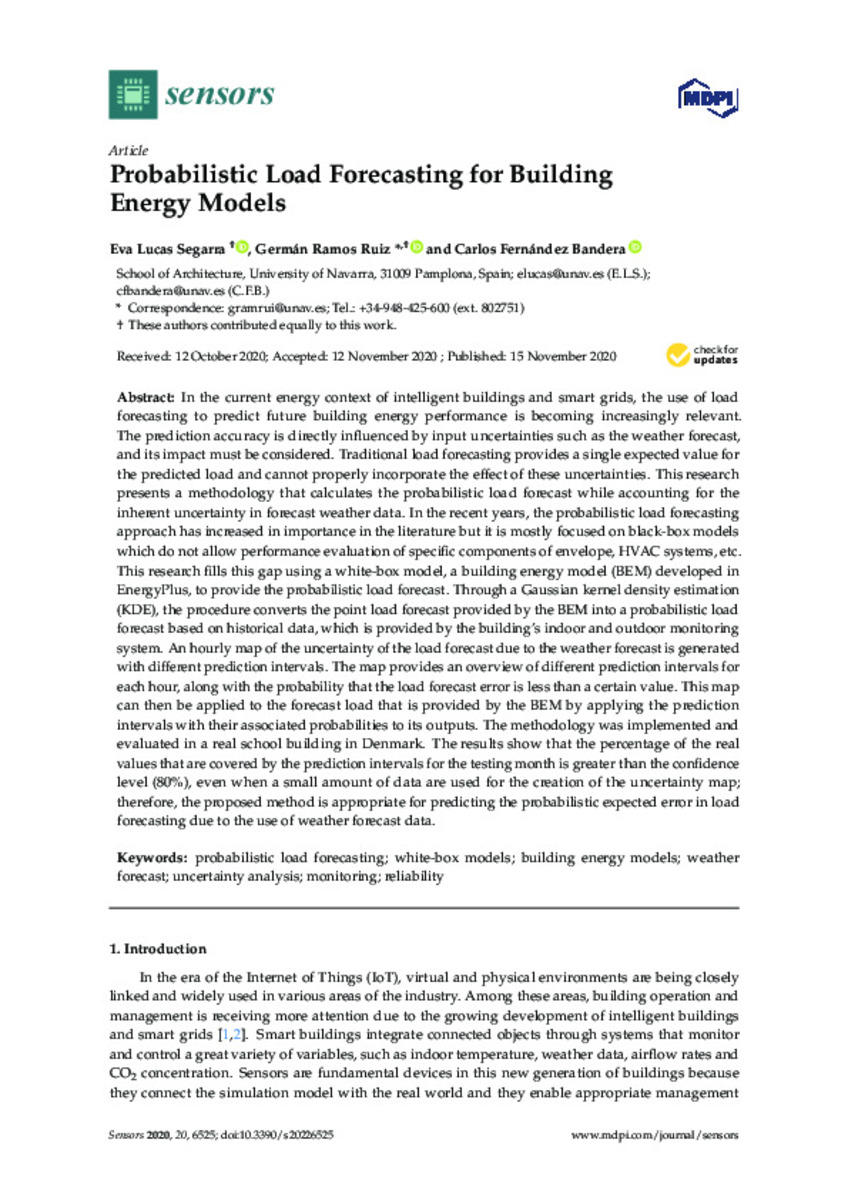Full metadata record
| DC Field | Value | Language |
|---|---|---|
| dc.creator | Lucas-Segarra, E. (Eva) | - |
| dc.creator | Ramos-Ruiz, G. (Germán) | - |
| dc.creator | Fernández-Bandera, C. (Carlos) | - |
| dc.date.accessioned | 2023-10-23T13:13:51Z | - |
| dc.date.available | 2023-10-23T13:13:51Z | - |
| dc.date.issued | 2020 | - |
| dc.identifier.citation | Lucas-Segarra, E. (Eva); Ramos-Ruiz, G. (Germán); Fernández-Bandera, C. (Carlos). "Probabilistic load forecasting for building energy models". Sensors. 20 (22), 2020, 6525 | es |
| dc.identifier.issn | 1424-8220 | - |
| dc.identifier.uri | https://hdl.handle.net/10171/67705 | - |
| dc.description.abstract | In the current energy context of intelligent buildings and smart grids, the use of load forecasting to predict future building energy performance is becoming increasingly relevant. The prediction accuracy is directly influenced by input uncertainties such as the weather forecast, and its impact must be considered. Traditional load forecasting provides a single expected value for the predicted load and cannot properly incorporate the effect of these uncertainties. This research presents a methodology that calculates the probabilistic load forecast while accounting for the inherent uncertainty in forecast weather data. In the recent years, the probabilistic load forecasting approach has increased in importance in the literature but it is mostly focused on black-box models which do not allow performance evaluation of specific components of envelope, HVAC systems, etc. This research fills this gap using a white-box model, a building energy model (BEM) developed in EnergyPlus, to provide the probabilistic load forecast. Through a Gaussian kernel density estimation (KDE), the procedure converts the point load forecast provided by the BEM into a probabilistic load forecast based on historical data, which is provided by the building’s indoor and outdoor monitoring system. An hourly map of the uncertainty of the load forecast due to the weather forecast is generated with different prediction intervals. The map provides an overview of different prediction intervals for each hour, along with the probability that the load forecast error is less than a certain value. This map can then be applied to the forecast load that is provided by the BEM by applying the prediction intervals with their associated probabilities to its outputs. The methodology was implemented and evaluated in a real school building in Denmark. The results show that the percentage of the real values that are covered by the prediction intervals for the testing month is greater than the confidence level (80%), even when a small amount of data are used for the creation of the uncertainty map; therefore, the proposed method is appropriate for predicting the probabilistic expected error in load forecasting due to the use of weather forecast data. | es_ES |
| dc.description.sponsorship | This project received funding from the European Union’s Horizon 2020 research and innovation program under Grant Agreement No. 731211, project SABINA. | es_ES |
| dc.language.iso | eng | es_ES |
| dc.publisher | MDPI AG | es_ES |
| dc.relation | info:eu-repo/grantAgreement/EC/H2020/731211/EU | es_ES |
| dc.rights | info:eu-repo/semantics/openAccess | es_ES |
| dc.subject | Probabilistic load forecasting | es_ES |
| dc.subject | White-box models | es_ES |
| dc.subject | Building energy models | es_ES |
| dc.subject | Weather forecast | es_ES |
| dc.subject | Uncertainty analysis | es_ES |
| dc.subject | Monitoring | es_ES |
| dc.subject | Reliability | es_ES |
| dc.title | Probabilistic load forecasting for building energy models | es_ES |
| dc.type | info:eu-repo/semantics/article | es_ES |
| dc.description.note | This article is an open access article distributed under the terms and conditions of the Creative Commons Attribution (CC BY) license (http://creativecommons.org/licenses/by/4.0/). | es_ES |
| dc.identifier.doi | 10.3390/s20226525 | - |
| dadun.citation.number | 22 | es_ES |
| dadun.citation.publicationName | Sensors | es_ES |
| dadun.citation.startingPage | 6525 | es_ES |
| dadun.citation.volume | 20 | es_ES |
| dc.identifier.pmid | 33203080 | - |
Files in This Item:
Statistics and impact
Items in Dadun are protected by copyright, with all rights reserved, unless otherwise indicated.






